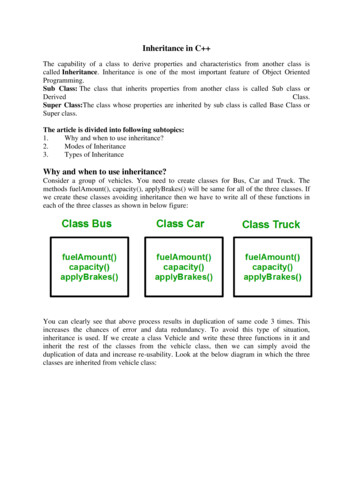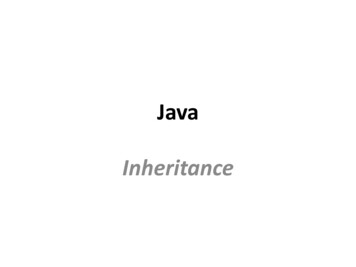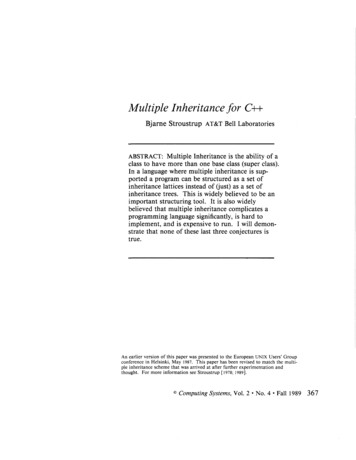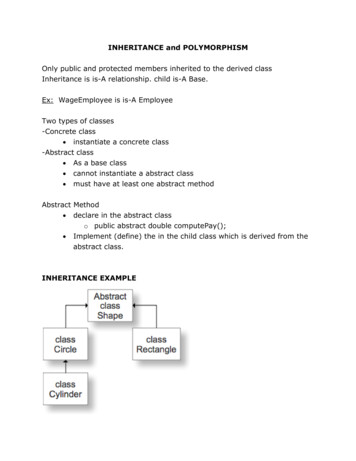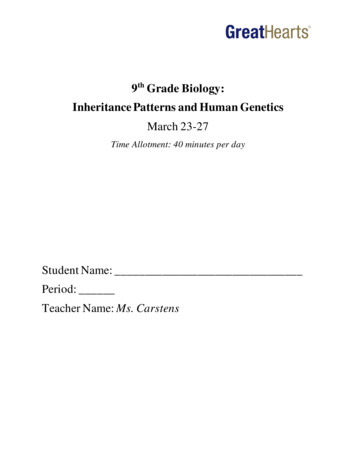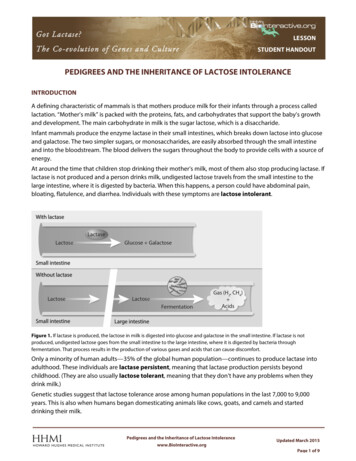
Transcription
test:TheSelectionCo-evolutionof Genes and tationLESSONSTUDENT HANDOUTPEDIGREES AND THE INHERITANCE OF LACTOSE INTOLERANCEINTRODUCTIONA defining characteristic of mammals is that mothers produce milk for their infants through a process calledlactation. “Mother’s milk” is packed with the proteins, fats, and carbohydrates that support the baby’s growthand development. The main carbohydrate in milk is the sugar lactose, which is a disaccharide.Infant mammals produce the enzyme lactase in their small intestines, which breaks down lactose into glucoseand galactose. The two simpler sugars, or monosaccharides, are easily absorbed through the small intestineand into the bloodstream. The blood delivers the sugars throughout the body to provide cells with a source ofenergy.At around the time that children stop drinking their mother’s milk, most of them also stop producing lactase. Iflactase is not produced and a person drinks milk, undigested lactose travels from the small intestine to thelarge intestine, where it is digested by bacteria. When this happens, a person could have abdominal pain,bloating, flatulence, and diarrhea. Individuals with these symptoms are lactose intolerant.Figure 1. If lactase is produced, the lactose in milk is digested into glucose and galactose in the small intestine. If lactase is notproduced, undigested lactose goes from the small intestine to the large intestine, where it is digested by bacteria throughfermentation. That process results in the production of various gases and acids that can cause discomfort.Only a minority of human adults—35% of the global human population—continues to produce lactase intoadulthood. These individuals are lactase persistent, meaning that lactase production persists beyondchildhood. (They are also usually lactose tolerant, meaning that they don’t have any problems when theydrink milk.)Genetic studies suggest that lactose tolerance arose among human populations in the last 7,000 to 9,000years. This is also when humans began domesticating animals like cows, goats, and camels and starteddrinking their milk.Pedigrees and the Inheritance of Lactose Intolerancewww.BioInteractive.orgUpdated March 2015Page 1 of 9
Got Lactase?LESSONThe Co-evolution of Genes and CultureSTUDENT HANDOUTThe film Got Lactase? The Co-evolution of Genes and Culture traces the evolution of lactose tolerance. It alsodescribes how researchers analyzed the pedigrees of several Finnish families to identify the changes in theDNA, or mutations, responsible for this trait.In this activity, you will analyze some of those pedigrees to determine how the lactose tolerant trait isinherited. You will then analyze DNA sequences to identify mutations associated with the trait.PROCEDUREPart 1: Determining the Pattern of Inheritance of Lactose Tolerance/IntoleranceTo determine how lactose tolerance/intolerance is inherited, researchers examined nine extended Finnishfamilies for five generations.Below is one of those pedigrees. Look at the pedigree and then answer the questions below. (For a refresheron pedigrees, refer to Appendix A on the last page of this document.)Figure 2. Pedigree of Family A. (Adapted from a figure in Enattah, N. S., et al. 2002 Nature Genetics 30: 233-237.)1. Based on the pedigree above, which of the following terms are appropriate for describing the inheritance ofthe lactose-intolerance trait (filled-in symbols)? Check all that apply.RecessiveDominantInheritedX-linkedPedigrees and the Inheritance of Lactose Intolerancewww.biointeractive.orgPage 2 of 9
Got Lactase?LESSONThe Co-evolution of Genes and CultureSTUDENT HANDOUT2. Which of the following terms are appropriate for describing the inheritance of the lactose-tolerance trait(empty symbols)? Check all that apply.RecessiveDominantInheritedX-linked3. Use the data in the pedigree and the terms listed in questions 1 and 2 to make a claim about how lactoseintolerance is inherited. Provide at least two pieces of evidence in support of your claim.4. How comfortable are you with drawing a firm claim about the inheritance of lactose intolerance? Whatmight you do next to increase your confidence in making this claim?5. Study Individuals 5 and 6 of Generation III in Family A and their child. The two parents are lactose tolerant,yet their son is lactose intolerant. Are these data consistent or inconsistent with the claim you made inquestion 3? Explain your answer.Pedigrees and the Inheritance of Lactose Intolerancewww.biointeractive.orgPage 3 of 9
Got Lactase?LESSONThe Co-evolution of Genes and CultureSTUDENT HANDOUTYou are now going to examine three additional pedigrees from the Finnish study.Figure 3. Pedigrees of Families B, C, and D. (Adapted from a figure in Enattah, N. S., et al. 2002 Nature Genetics 30: 233-237.)Pedigrees and the Inheritance of Lactose Intolerancewww.biointeractive.orgPage 4 of 9
Got Lactase?LESSONThe Co-evolution of Genes and CultureSTUDENT HANDOUT6. Do the data presented in these additional pedigrees support your claim in question 3 above? Explain youranswer.7. Based on your claim, which symbols would you use to represent the genotype of an individual who islactose tolerant? Lactose intolerant?8. Based on your claim, what is the genotype of Individual 3, Generation IV in Family C? Explain your answer.9. Based on the same claim, what is the genotype of the father of Individual 4, Generation IV in Family D?Explain your answer.10. Individuals 8 and 9, Generation IV in Family B are sisters. Based on your inheritance claims, what is/are thepossible genotype(s) of:a. Individual 9?b. Individual 8?c. The parents of Individuals 8 and 9?11. Individual 4, Generation IV in Family B is the sister of Individuals 8 and 9 in the question above. What is theprobability that Individual 4 is homozygous? Heterozygous?Pedigrees and the Inheritance of Lactose Intolerancewww.biointeractive.orgPage 5 of 9
Got Lactase?LESSONThe Co-evolution of Genes and CultureSTUDENT HANDOUTPart 2. Finding the Responsible MutationIn the film Got Lactase? The Co-evolution of Genes and Culture, you learned that researchers did not find anychanges in DNA sequence, or mutations, in the coding region of the lactase gene that were associated withlactose tolerance/intolerance. This finding suggested that the genetic change responsible for whethersomeone is lactose tolerant or intolerant is not in the coding region of the gene.Could the change be in the regulatory region of the gene?Genes are regulated, or turned on or off, by genetic elements called switches. When the lactase switch turnsthe lactase gene on, the lactase enzyme is produced. In babies, the lactase gene is turned on. But when babiesgrow into adults, the switch turns the lactase gene off in most people. In a minority of adults, a mutation in thelactase switch prevents the lactase gene from turning off. These adults are lactose tolerant.Figure 4. The genetic switch that regulates the expression of the lactase gene is active in babies but not in most human adults.Individuals who are lactose tolerant (or lactase persistent) have a mutation in the lactase switch that keeps the switch turned on intoadulthood.To find the mutation that keeps the lactase gene on, researchers analyzed the DNA sequence of the lactaseswitch in several individuals. They found many differences. For example, at one particular position in thesequence of DNA, some individuals might have an adenine (A) nucleotide and others a thymine (T) nucleotide.Most of the differences in DNA sequence have no effect on lactase production. To detect changes in DNA thatare associated with lactose tolerance, researchers looked for variations that are consistently found in peoplewho are lactose tolerant but not in people who are lactose intolerant, and vice versa.You will now do the same.Pedigrees and the Inheritance of Lactose Intolerancewww.biointeractive.orgPage 6 of 9
Got Lactase?LESSONThe Co-evolution of Genes and CultureSTUDENT HANDOUTTables 1 and 2 show DNA sequences from two short regions of DNA on chromosome 2. Because eachindividual has two copies of chromosome 2 (one from each parent), each table includes two DNA sequencesper person. Individuals are identified by generation number and individual number. For example, Individual BIV-4 is Individual 4, Generation IV in Family B.Table 1. DNA Sequence 1 from Lactose-Tolerant and -Intolerant IndividualsIndividualPhenotypeA IV-3Sequence 1*Copy 1, Chromosome 2: TAAGATAATGTAGTCCCTGGCopy 2, Chromosome 2: TAAGATAATGTAGTCCCTGGB IV-4Copy 1, Chromosome 2: TAAGATAATGTAGTCCCTGGCopy 2, Chromosome 2: TAAGATAATGTAGTCCCTGGB IV-8Copy 1, Chromosome 2: TAAGATAATGTAGTCCCTGGCopy 2, Chromosome 2: TAAGATAATGTAGCCCCTGGB IV-9Copy 1, Chromosome 2: TAAGATAATGTAGCCCCTGGCopy 2, Chromosome 2: TAAGATAATGTAGCCCCTGGC IV-3Copy 1, Chromosome 2: TAAGATAATGTAGTCCCTGGCopy 2, Chromosome 2: TAAGATAATGTAGCCCCTGGD IV-4Copy 1, Chromosome 2: TAAGATAATGTAGCCCCTGGCopy 2, Chromosome 2: TAAGATAATGTAGCCCCTGG*Sequence 1 is a nucleotide sequence corresponding to nucleotides 19923-13902 upstream from the start of the lactase gene.Table 2. DNA Sequence 2 from Lactose-Tolerant and -Intolerant IndividualsIndividualA IV-3PhenotypeSequence 2*Copy 1, Chromosome 2: ATAAAGGACACTCTTGACAACopy 2, Chromosome 2: ATAAAGGACACTCTTGACAAB IV-4Copy 1, Chromosome 2: ATAAAGGACACTCTTGACAACopy 2, Chromosome 2: ATAAAGGACACTCTTGACAAB IV-8Copy 1, Chromosome 2: ATAAAGGACACTCTTGACAACopy 2, Chromosome 2: ATAAAGGACGCTCTTGACAAB IV-9Copy 1, Chromosome 2: ATAAAGGACGCTCTTGACAACopy 2, Chromosome 2: ATAAAGGACGCTCTTGACAAC IV-3Copy 1, Chromosome 2: ATAAAGGACACTCTTGACAACopy 2, Chromosome 2: ATAAAGGACACTCTTGACAAD IV-4Copy 1, Chromosome 2: ATAAAGGACACTCTTGACAACopy 2, Chromosome 2: ATAAAGGACACTCTTGACAA*Sequence 2 is a nucleotide sequence corresponding to nucleotides 30192-30173 upstream of the start of the lactase gene.Pedigrees and the Inheritance of Lactose Intolerancewww.biointeractive.orgPage 7 of 9
Got Lactase?LESSONThe Co-evolution of Genes and CultureSTUDENT HANDOUT1. Study the two tables above. Fill in the phenotype (e.g., lactose tolerant or lactose intolerant) of eachindividual in the second column of the table. (You will need to look at the pedigrees in Part 1 to complete thisstep.)2. Identify and circle all the nucleotides that differ between at least two sequences in each table.3. Pretend that you are the researcher who discovered the variations and you are writing to a colleaguedescribing what you found.a. How would you describe the variation(s) you found in Sequence 1?b. How would you describe the variation(s) you found in Sequence 2?4. Based on the sequence data you analyzed, which variation is associated with lactose tolerance (lactasepersistence)? Support your claim by providing at least three pieces of evidence.5. Is the variation associated with lactose tolerance (lactase persistence) found on one chromosome or bothchromosomes in individuals with the trait? Explain your answer.6. From the pedigrees and the DNA sequencing data, what do you know about how the variation associatedwith lactose tolerance was inherited for Individuals B IV-4 and B IV-9?7. The mutation associated with lactose tolerance keeps the lactase gene turned on in adults. Based on thesequence and pedigree data, what can you infer about the regulation of the lactase gene in Individual A IV-3?Explain.Pedigrees and the Inheritance of Lactose Intolerancewww.biointeractive.orgPage 8 of 9
Got Lactase?LESSONThe Co-evolution of Genes and CultureSTUDENT HANDOUTAPPENDIX A. PEDIGREE CHARTSA pedigree chart is a tool that helps illustrate how a trait is inherited from one generation to the next. Below isa pedigree chart that includes three generations of an extended family.Pedigrees and the Inheritance of Lactose Intolerancewww.biointeractive.orgPage 9 of 9
Pedigrees and the Inheritance of Lactose Intolerance PEDIGREES AND THE INHERITANCE OF LACTOSE INTOLERANCE INTRODUCTION A defining characteristic of mammals is that mothers produce milk for their infants through a process called lactation. "Mother's milk" is packed with the proteins, fats, and carbohydrates that support the baby's growth



